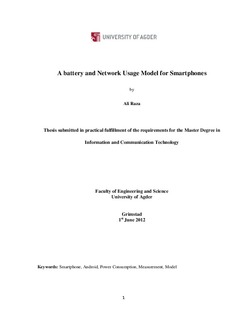| dc.description.abstract | Smartphones have emerged into platforms with powerful computational capabilities that generate large amount of data. Smartphones have become an important part of our daily life and we use smartphones more frequently than we used desktop computers to stay connected on internet, reading news, playing games, browsing, watching video and staying connected with friends through social networking websites like Facebook and Tweeter. On the other hand the smartphones have a strict energy budget and limited lifetime on a single charge. Thus it very important, for manufacturers and users, that smart devices and smartphones and the applications running on smartphones, must be very energy efficient. For this purpose it is very important to understand how and where the energy is used in a smartphone. Also how much of the smartphones‟ energy is consumed by what application and under what circumstances. In this thesis we have considered a few popular and commonly used applications on smartphones to analyze their power consumption and then develop a power consumption model for smartphone while running those applications. The platform we studied is Android and the Device under Test (DUT) is Samsung Sidekick 4G and Google Nexus One smartphone. Android is the most famous OS for smartphones that can be defined as, “a software stack for mobile devices that includes an operating system, middleware and key applications”. We relied on three software tools for power consumption measurements of the applications running on smartphones. We have developed a power model for five commonly used applications on smartphone namely: Skype, Viber, Tango, YouTube and Facebook. We have analyzed the energy usage by these applications so that developers would focus on for further improvements of power management. | no_NO |
